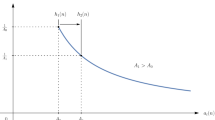Abstract
This paper presents a model of optimal economic growth with exogenous technical change that is embodied in people. That is, newly invented techniques can be used only if the production unit engages labour that has been trained to produce according to this new technique. The model illustrates the negative impact of slower population growth on the rate of technology adaptation. When the growth rate of population is high, the introduction of technological innovations into the production process is primarily achieved through the constant influx of recently educated young people. When the relative share of this influx is reduced, increased education becomes necessary in order to prevent the gap between technology in theory and technology in practice from becoming too large.
Similar content being viewed by others
References
Auerbach AJ, Kotlikoff LJ (1985) Simulating alternative social security responses to the demographic transition. Natl Tax J 38:153–168
Burmeister E, Dobell AR (1970) Mathematical theories of economic growth. MacMillan, London
Dorfman R (1969) An economic interpretation of optimal control theory. Am Econ Rev 59:817–831
Van Imhoff E (1988a) Optimal economic growth and non-stable population. PhD Thesis, Erasmus Universiteit, Rotterdam
Van Imhoff E (1988b) Optimal saving with capital-embodied technical change and non-stationary population. Working Paper WP-88–24, International Institute for Applied Systems Analysis, Laxenburg
Van Imhoff E (1989) Optimal investment in human capital under conditions of non-stable population. J Human Res 24 (in press)
Van Imhoff E, Ritzen JMM (1987) Neo-classical growth, savings, and non-stationary population. Paper presented at the European Population Conference, Jyvaskyla, June 11–16, 1987
Van Imhoff E, Ritzen JMM (1988) Optimal economic growth and non-stable population. Economist 136:339–357
Nelson RR, Phelps ES (1966) Investment in humans, technological diffusion, and economic growth. Am Econ Rev P & P 56:69–75
Phelps ES (1961) The golden rule of accumulation: a fable for growthmen. Am Econ Rev 51:638–643
Samuelson PA (1958) An exact consumption-loan model of interest with or without the social contrivance of money. J Polit Econ 66:467–482
Samuelson PA (1975) The optimum growth rate for population. Int Econ Rev 16:531–538
Sato R, Davis EG (1971) Optimal savings policy when labor grows endogenously. Econometrica 39:877–897
Solow RM (1956) A contribution to the theory of economic growth. Qu J Econ 70:65–94
Solow RM (1960) Investment and technical progress. In: Arrow KJ, Karlin S, Suppes P (eds) Mathematical methods in the social sciences. Stanford University Press, Stanford
Stephens KJ (1971) A growth model with capital and labour vintages. Metroeconomica 23:03–118
Author information
Authors and Affiliations
Additional information
I would like to thank an anonymous referee for helpful comments
Rights and permissions
About this article
Cite this article
van Imhoff, E. Age structure, education, and the transmission of technical change. J Popul Econ 1, 167–181 (1989). https://doi.org/10.1007/BF00161476
Received:
Accepted:
Issue Date:
DOI: https://doi.org/10.1007/BF00161476




